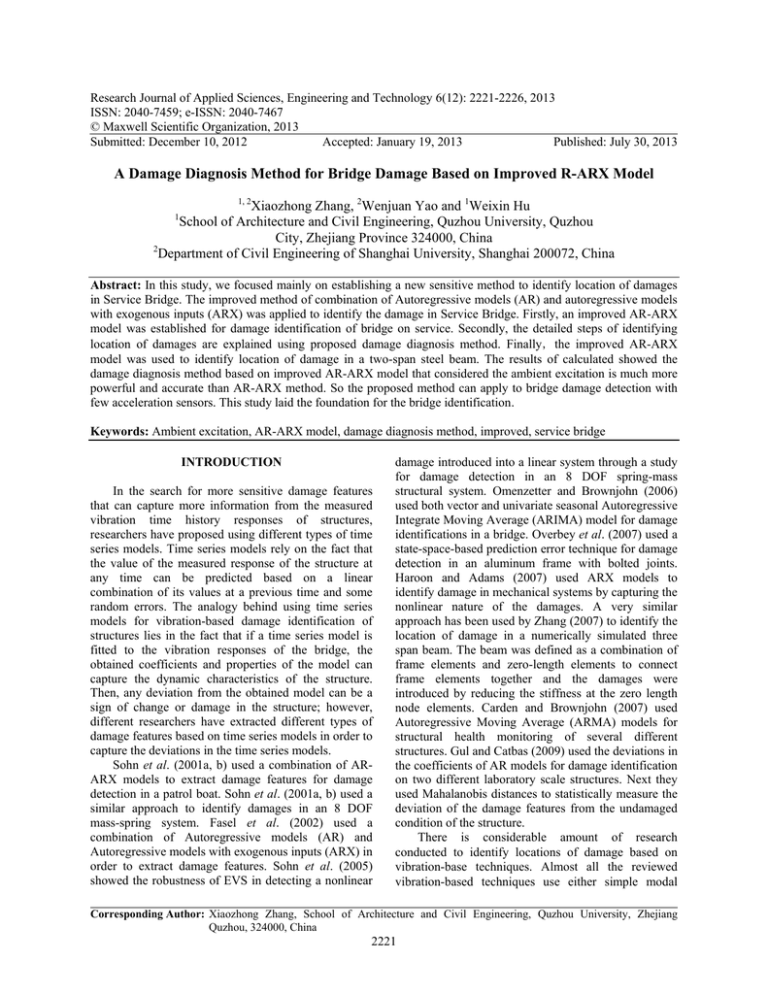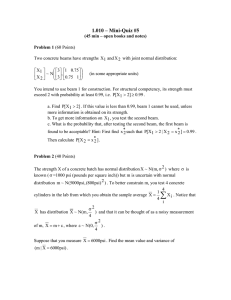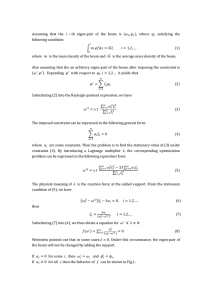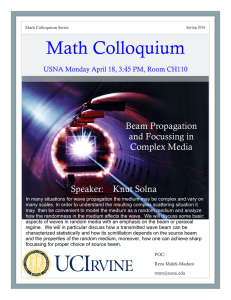Research Journal of Applied Sciences, Engineering and Technology 6(12): 2221-2226,... ISSN: 2040-7459; e-ISSN: 2040-7467
advertisement

Research Journal of Applied Sciences, Engineering and Technology 6(12): 2221-2226, 2013 ISSN: 2040-7459; e-ISSN: 2040-7467 © Maxwell Scientific Organization, 2013 Submitted: December 10, 2012 Accepted: January 19, 2013 Published: July 30, 2013 A Damage Diagnosis Method for Bridge Damage Based on Improved R-ARX Model 1, 2 Xiaozhong Zhang, 2Wenjuan Yao and 1Weixin Hu School of Architecture and Civil Engineering, Quzhou University, Quzhou City, Zhejiang Province 324000, China 2 Department of Civil Engineering of Shanghai University, Shanghai 200072, China 1 Abstract: In this study, we focused mainly on establishing a new sensitive method to identify location of damages in Service Bridge. The improved method of combination of Autoregressive models (AR) and autoregressive models with exogenous inputs (ARX) was applied to identify the damage in Service Bridge. Firstly, an improved AR-ARX model was established for damage identification of bridge on service. Secondly, the detailed steps of identifying location of damages are explained using proposed damage diagnosis method. Finally,the improved AR-ARX model was used to identify location of damage in a two-span steel beam. The results of calculated showed the damage diagnosis method based on improved AR-ARX model that considered the ambient excitation is much more powerful and accurate than AR-ARX method. So the proposed method can apply to bridge damage detection with few acceleration sensors. This study laid the foundation for the bridge identification. Keywords: Ambient excitation, AR-ARX model, damage diagnosis method, improved, service bridge INTRODUCTION In the search for more sensitive damage features that can capture more information from the measured vibration time history responses of structures, researchers have proposed using different types of time series models. Time series models rely on the fact that the value of the measured response of the structure at any time can be predicted based on a linear combination of its values at a previous time and some random errors. The analogy behind using time series models for vibration-based damage identification of structures lies in the fact that if a time series model is fitted to the vibration responses of the bridge, the obtained coefficients and properties of the model can capture the dynamic characteristics of the structure. Then, any deviation from the obtained model can be a sign of change or damage in the structure; however, different researchers have extracted different types of damage features based on time series models in order to capture the deviations in the time series models. Sohn et al. (2001a, b) used a combination of ARARX models to extract damage features for damage detection in a patrol boat. Sohn et al. (2001a, b) used a similar approach to identify damages in an 8 DOF mass-spring system. Fasel et al. (2002) used a combination of Autoregressive models (AR) and Autoregressive models with exogenous inputs (ARX) in order to extract damage features. Sohn et al. (2005) showed the robustness of EVS in detecting a nonlinear damage introduced into a linear system through a study for damage detection in an 8 DOF spring-mass structural system. Omenzetter and Brownjohn (2006) used both vector and univariate seasonal Autoregressive Integrate Moving Average (ARIMA) model for damage identifications in a bridge. Overbey et al. (2007) used a state-space-based prediction error technique for damage detection in an aluminum frame with bolted joints. Haroon and Adams (2007) used ARX models to identify damage in mechanical systems by capturing the nonlinear nature of the damages. A very similar approach has been used by Zhang (2007) to identify the location of damage in a numerically simulated three span beam. The beam was defined as a combination of frame elements and zero-length elements to connect frame elements together and the damages were introduced by reducing the stiffness at the zero length node elements. Carden and Brownjohn (2007) used Autoregressive Moving Average (ARMA) models for structural health monitoring of several different structures. Gul and Catbas (2009) used the deviations in the coefficients of AR models for damage identification on two different laboratory scale structures. Next they used Mahalanobis distances to statistically measure the deviation of the damage features from the undamaged condition of the structure. There is considerable amount of research conducted to identify locations of damage based on vibration-base techniques. Almost all the reviewed vibration-based techniques use either simple modal Corresponding Author: Xiaozhong Zhang, School of Architecture and Civil Engineering, Quzhou University, Zhejiang Quzhou, 324000, China 2221 Res. J. Appl. Sci. Eng. Technol., 6(12): 2221-2226, 2013 characteristics such as modal frequencies or modal shapes, some modally related indices such as flexibility matrix or some sort of model parameter updating. All these methods go through a process of data condensation. This means that the measured vibration data on the structure is used to derive a condensed set of information like natural frequencies, mode shapes or mode shape curvatures; however, a useful portion of the data could be lost during the data condensation process. The other problem of these methods is that usually a limited number of vibration modes are used in the reviewed methods in order to identify damages in the structures. In the search for more sensitive damage features that can capture more information from the measured vibration time history responses of structures, researchers have proposed using time series models. This research focuses mainly on developing a new damage feature to identify location of damages. The research starts with modifying a damage diagnosis method which was previously developed in the literature based on combination of AR-ARX time series models for identifying existence of damage and uses it to identify location of damage in a two-span steel beam. This model is called Moving Average (MA) model. In order to model responses of a complex dynamical system, higher order Autoregressive moving average, ARMA (p, q), models can be used: p q i =1 j =1 X t = ∑ ϕi X t −i + ∑ θ j et − j + et (3) where, = Xt Observation in the structural response at time t = ith predictor coefficients for the Autoregressive part of the model = jth predictor coefficients for the Moving Average part of the model = Residual error of the model prediction at time t = Orders of Autoregressive and Moving average terms of the model, respectively φi θj et P,q AR and MA model can be used to represent the same dynamical model interchangeably. X t Can be a stationary response of the structure only if φ 1 <1. Therefore, if the process has started at infinite past, the above equation can be written as: IMPROVED AR-ARX MODELS Autoregressive (AR) and Autoregressive Moving Average (ARMA) models: AR models are actually regression models that can predict the present observations in the structural response as sum of two uncorrelated parts, one is dependent on the previous observations in the structural response and the other one can be a series of uncorrelated sequences. The simplest such models are: X t = ϕX t −1 + et where, = Xt ϕ et = = (1) Xt = ϕ0 1 − ϕ1 If the number of modes excited in the dynamic response of the structure is n/2, then φ 1 can be written in term of natural frequencies of the structure: ϕ1 = (−1) m+1 n ∑λ λ λ i1 i1 ,i2im =1 i2 i3 λim (5) where, λi = i th pole of the system Observation in the structural response at time t Model constant A sequence of uncorrelated variables or the prediction error of the model Each pair of poles is related to the natural frequency, ω j and damping ratio, ζ j , of a mode through the following equation, where i = 2 j : λi , λi−1 = e The other simple time series model is when an observation can be related as sum of a series of uncorrelated sequences. The simplest such model can be represented as: X t = θet −1 + et where, θ = (4) + ∑ ϕ1j et − j Model constant (2) ∆ ( −ζ jω j ±ω j ζ 2j −1 ) (6) where, λ i-1 = Complex conjugate of λ i ∆ = The sampling time interval Therefore, if only modal properties of the structure are required, the vibration response can be modeled by just the AR part of the model. As a result, using AR models instead of ARMA models has the advantage of 2222 Res. J. Appl. Sci. Eng. Technol., 6(12): 2221-2226, 2013 less trial and error in estimating the model parameters. Another advantage of using AR models rather than ARMA models is the fact that a linear least-square method can be used for estimating AR parameters while a nonlinear least-square technique is required for estimating parameters of an ARMA model. The method that can be used to identify the proper orders for the times series models are the autocorrelation and partial autocorrelation functions. Autocorrelation function can be defined as: ρ ( h) = Cov( X t , X t +h ) γ ( h) = γ (0) Var ( X t ) Var ( X t +h ) (7) where, γ (h) = Auto covariance function of an observation with itself in a time shift h Cov( X t , X t +h ) = Covariance of an observation with itself in a time shift h = Variance of the observation Var ( X t ) Partial autocorrelation function, Φ(h) , is also defined as: Cov( X t − Xˆ t , X t +h − Xˆ t +h ) Var ( X − Xˆ ) Var ( X − Xˆ Φ ( h) = t t t +h (8) t +h ) where, X̂ t = The best linear unbiased predictor of X t . Autoregressive with exogenous (ARX) inputs models: Autoregressive with exogenous (ARX) model can be represented as the following: a b i =1 j =1 X t = ∑ α i X t −i + ∑ β j et − j + ε t where, = αi βj = εt = e t-j = where, a = Order of the AR part of the ARX model b = Order of the exogenous part of the ARX model p = Order of the AR model in Eq. (3) Estimating parameters of an ARX model can be treated as a linear regression problem using least-square techniques. A model will be regressed on the observation values at previous times and some external inputs, which can be taken from the error term in the AR model, to predict the value of the observation at a present time. DAMAGE DIAGNOSIS METHOD These damage diagnosis approaches based on ARARX models are proposed in four steps are shown in Fig. 1: (9) Predictor coefficients for the AR part of the model at time lag i Predictor coefficients for the exogenous part of the model at time lag j Residual error of the model prediction at time t External input to the model at time t-j; α,b Orders of Autoregressive and exogenous terms of the model, respectively It can be shown that the ARX model is a linear approximation of an ARMA model for a stationary time series. So it is suggested that orders of the AR part and exogenous part in the ARX model are chosen so that: a+b≤ p Fig. 1: Steps of damage diagnosis approach (10) • • • • Data sample formation Data normalization Damage feature extraction Statistical evaluation During these four steps, the vibration responses of the structure obtained at its healthy and damage conditions will be indirectly compared to each other by extracting sensitive damage features. The damage features will be obtained by application of AR and ARX models to the measured vibration response of the structure and probability values will be used to statistically measure the amount of variations in the extracted damage features from healthy to the damage condition of the structure. 2223 Res. J. Appl. Sci. Eng. Technol., 6(12): 2221-2226, 2013 IMPLEMENTING THE DAMAGE DIAGNOSIS METHODS One 330 s acceleration time histories measured at different damage conditions of the beam were used to evaluate the ability of the proposed damage diagnosis method to identify damage locations on the beam. The geometry of the beam is shown as Fig. 2. The vibration responses measured at different damage conditions of the beam were indirectly compared to the vibration responses measured at its healthy condition. All the vibration responses used for this comparison were measured under the same random loading excitations. The vibration responses of the beam were used to extract damage features and to evaluate the probability of occurring damage at different sensor locations along the length of the beam. Generation of these smaller data samples in the Reference, Healthy and Damage data sets are shown in Fig. 3 and 4. One of the reasons for segmenting the vibration response of the beam to smaller data samples was to form data samples which represent the response of the beam under varying loading conditions. A better match can be found for the data samples in the Healthy and Damaged data sets in the pool of Reference data samples that represent similar operational conditions of the beam. The average correlation values calculated for between the AR model coefficients of the Healthy and Damage data samples and the AR model coefficients of the matched Reference data samples are presented in Table 1. The matched data samples in different data sets can potentially represent the responses of the beam that are obtained under similar loading conditions. The average values of these calculated damage features are presented in Table 2 for different sensor locations at different conditions of the beam. As can be seen, the average damage features for different sensors in the healthy condition beam are closer to 1, as expected. As the damage grows, the average damage features grow. The larger the damage features are, the greater the likelihood is that damage is located at that sensor location. Probability densities of the transformed damage features are plotted in Fig. 5 for different sensors at damage conditions D11 to D15. Therefore, although the existence of damages can be detected by observing Fig. 2: Geometry of the beam Fig. 3: Smaller data samples generated in reference data sets Fig. 4: Smaller data samples generated in healthy and damage data sets Fig. 5: Probability density plots of the transferred damage features for sensors1 1 to 15 for different damage conditions at the damage location the deviations in the probability density plots of the damage features with respect to the healthy condition of the beam, it is difficult to quantify the extent of damages by measuring the amount of deviations. In order to identify the damage location, the amount of deviation in the probability density plots should be compared between different sensors. 2224 Res. J. Appl. Sci. Eng. Technol., 6(12): 2221-2226, 2013 Table 1: Average correlation values between the coefficients of the AR models fitted to the matched data samples in the healthy and damage data sets and the reference data sets Sensor Healthy D11 D12 D13 D14 D15 D21 D22 D23 D24 1 0.993 0.952 0.967 0.952 0.937 0.944 0.946 0.95 0.927 0.958 2 0.992 0.914 0.962 0.916 0.901 0.903 0.901 0.903 0.921 0.936 3 0.99 0.959 0.965 0.958 0.908 0.915 0.917 0.921 0.946 0.974 4 0.991 0.951 0.976 0.952 0.944 0.938 0.938 0.947 0.937 0.973 5 0.991 0.967 0.964 0.968 0.931 0.928 0.929 0.925 0.942 0.983 6 0.995 0.975 0.967 0.975 0.967 0.954 0.954 0.965 0.954 0.987 7 0.995 0.985 0.971 0.986 0.956 0.943 0.942 0.946 0.948 0.985 8 0.992 0.965 0.965 0.965 0.951 0.937 0.939 0.944 0.941 0.976 9 0.992 0.972 0.973 0.976 0.957 0.911 0.916 0.953 0.927 0.977 10 0.985 0.966 0.97 0.967 0.938 0.926 0.928 0.939 0.925 0.956 11 0.982 0.944 0.968 0.945 0.908 0.897 0.899 0.914 0.913 0.968 12 0.987 0.971 0.977 0.973 0.924 0.928 0.928 0.921 0.905 0.946 13 0.981 0.958 0.969 0.958 0.945 0.925 0.925 0.934 0.923 0.953 14 0.986 0.976 0.977 0.976 0.935 0.928 0.927 0.922 0.918 0.965 15 0.984 0.969 0.976 0.969 0.938 0.939 0.941 0.944 0.938 0.953 Table 2: Average damage features extracted from different sensors at different conditions of the beam Sensor Healthy D11 D12 D13 D14 D15 D21 1 1.23 1.46 1.53 1.76 1.94 1.17 1.49 2 1.19 1.35 1.45 2.84 2.75 1.94 2.31 3 1.43 2.17 1.76 2.38 3.37 2.15 2.95 4 1.21 1.98 1.54 1.98 3.90 2.06 3.15 5 1.23 5.55 4.06 5.56 8.05 6.49 7.12 6 1.36 1.83 1.55 1.71 2.34 2.61 3.55 7 1.21 2.03 1.68 1.75 2.65 2.43 2.89 8 1.21 2.04 1.53 1.69 2.43 1.86 2.16 9 1.21 2.59 1.79 2.55 4.37 2.26 2.99 10 1.23 1.81 1.46 1.64 4.51 2.69 4.03 11 1.19 2.23 1.86 2.13 4.55 3.17 4.64 12 1.47 2.65 1.98 2.26 4.49 3.69 5.73 13 1.18 1.79 1.43 1.89 2.88 1.65 2.09 14 1.16 1.73 1.54 1.64 3.30 2.97 3.15 15 1.22 2.25 1.57 1.96 4.45 2.05 3.16 D22 2.21 3.24 4.37 4.82 10.88 4,16 5.53 4,17 6.27 6.66 8.41 7.68 3.88 6.55 5.64 D23 2.36 3.76 4.88 5.94 13.66 4.95 4.70 3.56 6.75 8.15 9.75 8.36 4.32 4.27 6.77 D24 1.78 2.08 3.48 3.68 9.09 2.88 2.96 2.57 4.33 5.54 7.76 5.76 3.43 3.25 4.37 CONCLUSION This research focuses mainly on developing a new damage feature to identify location of damages. The research established a damage diagnosis method based on combination of AR-ARX time series models for identifying existence of damage and uses it to identify location of damage in a two-span steel beam. The results of experiment proposed damage diagnosis method is able to locate the general damage region in bridge girders. ACKNOWLEDGMENT Fig. 6: Fisher criterion calculated for different sensors at (a) D11, (b) D12 damage conditions The sensor which corresponds to the highest value of the calculated Fisher criterion is potentially a sensor located close to the physical damage location. The calculated Fisher criterion values in Fig. 6 are related to the conditions where damage was only induced at the damage location. This study was financially supported by Zhejiang Provincial Education Department’s research projects, the project name: Synchronous Identification Method of Structural damage and load under ambient excitation, project number: Y201223039. REFERENCES Carden, E.P. and J.M.W. Brownjohn, 2007. ARMA modeled time-series classification for structural health monitoring of civil infrastructures. Mech. Syst. Signal Process., 22(2): 295-314. 2225 Res. J. Appl. Sci. Eng. Technol., 6(12): 2221-2226, 2013 Fasel, T.R., S.W. Gregg, T.J. Johnson, C. Farrar and H. Sohn, 2002. Experimental modal analysis and damage detection in a simulated three story building. Proceedings of the 20th International Modal Analysis Conference (IMAC). Los Angeles, CA, pp: 590-595. Gul, M. and F.N. Catbas, 2009. Statistical pattern recognition for structural health monitoring using time series modeling: Theory and experimental verifications. Mech. Syst. Signal Process., 23(7): 2192-2204. Haroon, M. and D.E. Adams, 2007. Time and frequency domain nonlinear system charac terization for mechanical fault identification. Nonlinear Dyn., 50(3): 387-408. Omenzetter, P. and J.M.W. Brownjohn, 2006. Application of time series analysis for bridge monitoring. Smart Mater. Struct., 15(1): 129-138. Overbey, L.A., C.C. Olson and M.D. Todd, 2007. A parametric investigation of state-spacebased prediction error methods with stochastic excitation for structural health monitoring. Smart Mater. Struct., 16(5): 1621-1638. Sohn, H., C.R. Farrar, N.F. Hunter and K. Worden, 2001a. Structural health monitoring using statistical pattern recognition techniques. J. Dyn. Syst. Meas. Control, 123(4): 706-711. Sohn, H., C.R. Farrar, N.F. Hunter and K. Worden, 2001b. Applying the LANL statistical pattern recognition paradigm for structural health monitoring to data from a surface-effect fast patrol boat. Los Alamos National Laboratory Report, LA13761-MS. Sohn, H., D.W. Allen, K. Worden and C.R. Farrar, 2005. Structural damage classification using extreme value statistics. J. Dyn. Syst. Meas. Control, 127(1): 125-132. Zhang, Q.W., 2007. Statistical damage identification for bridges using ambient vibration data. Comput. Struct., 85(7-8): 476-485. 2226








